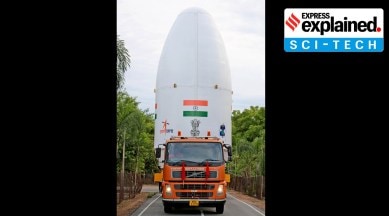Chandrayaan-3 ‘mated’ with its launch vehicle LVM3: What this means
The Chandrayaan-3 mission, slated to be launched between July 12 and 19, will be India’s second attempt to make a spacecraft land on the Moon. On July 5, it took one step towards its destination. We explain the what and the why of it.

The Indian Space Research Organisation (Isro) on July 5 announced that it had successfully integrated the Chandrayaan-3 spacecraft with the launch vehicle, Launch Vehicle Mark-III (LVM3), at the Satish Dhawan Space Centre in Andhra Pradesh’s Sriharikota.
In a tweet, Isro said, “LVM3-M4/Chandrayaan-3 Mission: Today, at Satish Dhawan Space Centre, Sriharikota, the encapsulated assembly containing Chandrayaan-3 is mated with LVM3.”
monthly limit of free stories.
with an Express account.
The Chandrayaan-3 mission, slated to be launched between July 12 and 19, will be India’s second attempt to make a spacecraft land on the Moon. The Chandrayaan-2 mission, launched on July 22, 2019, had partially failed after its lander and rover crashed on the Moon during the early hours of September 6.
Why has Chandrayaan-3 been integrated with LVM3?
The Chandrayaan-3, which consists of a lander, rover and propulsion module, can’t travel to space on its own. It needs to be attached — like any satellite — to launch vehicles or rockets, like the LVM3 in this case. Rockets have powerful propulsion systems that generate the huge amount of energy required to lift heavy objects like satellites into space, overcoming the gravitational pull of the Earth.
What is LVM3?
LVM3 is India’s heaviest rocket, with a gross lift-off weight of 640 tonnes, an overall length of 43.5m and 5m-diameter payload fairing (nose-shaped equipment to protect the rocket from aerodynamic forces). The launch vehicle can carry up to 8 tonnes of payload to the lower earth orbits (LEO), which is about 200 km from the Earth’s surface. But when it comes to the geostationary transfer orbits (GTO), which lie much further ahead, up to about 35,000 km from the Earth, it can carry much less, only about four tonnes.
This, however, does not mean that LVM3 is weak compared to rockets used by other countries or space companies for similar jobs. For instance, the European Space Agency’s (ESA) Ariane5 rocket has a lift-off mass of 780 tonnes and can carry 20 tonnes of payloads to LEO and 10 tonnes to GTO.
LVM3 made its first journey into space in 2014 and also carried the Chandrayaan-2 in 2019. Most recently, in March this year, it placed 36 OneWeb satellites, weighing about 6,000kg, in LEO, showing its capabilities to deliver multiple satellites into space. This was the second time that LVM3 made a commercial launch — the first one came in October 2022 when it delivered the OneWeb India-1 mission.
What are the various components of LVM3?
Rockets have several detachable energy-providing parts. They burn different kinds of fuels to power the rocket. Once their fuel is exhausted, they detach from the rocket and fall off, often burning off in the atmosphere due to air friction, and getting destroyed. Only a small part of the original rocket goes to the intended destination of the satellite, like Chandrayaan-3. Once the satellite is finally ejected, this last part of the rocket either becomes part of space debris or once again burns off after falling into the atmosphere.
LVM3 is essentially a three-stage launch vehicle, including two solid boosters (S200), the core liquid fuel-based stage (L110), and the cryogenic upper stage (C25).
According to Isro: “The vehicle takes off with the simultaneous ignition of the two S200 boosters. The core stage (L110) is ignited at about 113s (seconds) through the flight, during the firing of the S200 stages. Both S200 motors burn for about 134s and the separation occurs at 137s. The payload fairing is separated at an altitude of 115 km and at about 217s during L110 firing. The L110 burnout and separation and C25 ignition occur at 313s. The spacecraft is injected into a GTO (Geosynchronous Transfer Orbit) orbit of 180×36000 km at a nominal time of 974s.”